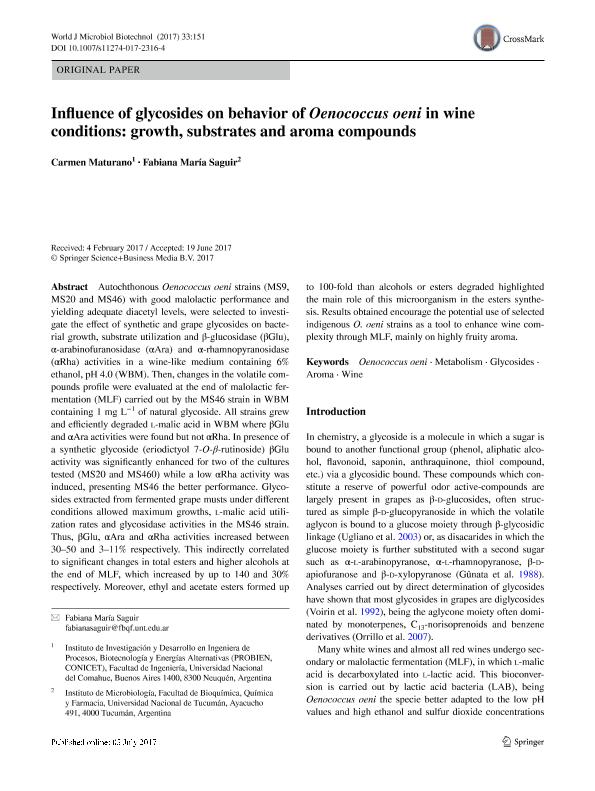Mostrar el registro sencillo del ítem
dc.contributor.author
Maturano, Ramona del Carmen

dc.contributor.author
Saguir de Zucal, Fabiana Maria

dc.date.available
2018-11-26T16:47:30Z
dc.date.issued
2017-08-03
dc.identifier.citation
Maturano, Ramona del Carmen; Saguir de Zucal, Fabiana Maria; Influence of glycosides on behavior of Oenococcus oeni in wine conditions: growth, substrates and aroma compounds; Springer; World Journal of Microbiology; 33; 8; 3-8-2017; 1-12
dc.identifier.issn
0959-3993
dc.identifier.uri
http://hdl.handle.net/11336/65167
dc.description.abstract
Autochthonous Oenococcus oeni strains (MS9, MS20 and MS46) with good malolactic performance and yielding adequate diacetyl levels, were selected to investigate the effect of synthetic and grape glycosides on bacterial growth, substrate utilization and β-glucosidase (βGlu), α-arabinofuranosidase (αAra) and α-rhamnopyranosidase (αRha) activities in a wine-like medium containing 6% ethanol, pH 4.0 (WBM). Then, changes in the volatile compounds profile were evaluated at the end of malolactic fermentation (MLF) carried out by the MS46 strain in WBM containing 1 mg L−1 of natural glycoside. All strains grew and efficiently degraded l-malic acid in WBM where βGlu and αAra activities were found but not αRha. In presence of a synthetic glycoside (eriodictyol 7-O-β-rutinoside) βGlu activity was significantly enhanced for two of the cultures tested (MS20 and MS460) while a low αRha activity was induced, presenting MS46 the better performance. Glycosides extracted from fermented grape musts under different conditions allowed maximum growths, l-malic acid utilization rates and glycosidase activities in the MS46 strain. Thus, βGlu, αAra and αRha activities increased between 30–50 and 3–11% respectively. This indirectly correlated to significant changes in total esters and higher alcohols at the end of MLF, which increased by up to 140 and 30% respectively. Moreover, ethyl and acetate esters formed up to 100-fold than alcohols or esters degraded highlighted the main role of this microorganism in the esters synthesis. Results obtained encourage the potential use of selected indigenous O. oeni strains as a tool to enhance wine complexity through MLF, mainly on highly fruity aroma.
dc.format
application/pdf
dc.language.iso
eng
dc.publisher
Springer

dc.rights
info:eu-repo/semantics/openAccess
dc.rights.uri
https://creativecommons.org/licenses/by-nc-sa/2.5/ar/
dc.subject
Aroma
dc.subject
Glycosides
dc.subject
Metabolism
dc.subject
Oenococcus Oeni
dc.subject
Wine
dc.subject.classification
Alimentos y Bebidas

dc.subject.classification
Otras Ingenierías y Tecnologías

dc.subject.classification
INGENIERÍAS Y TECNOLOGÍAS

dc.title
Influence of glycosides on behavior of Oenococcus oeni in wine conditions: growth, substrates and aroma compounds
dc.type
info:eu-repo/semantics/article
dc.type
info:ar-repo/semantics/artículo
dc.type
info:eu-repo/semantics/publishedVersion
dc.date.updated
2018-10-23T16:33:13Z
dc.journal.volume
33
dc.journal.number
8
dc.journal.pagination
1-12
dc.journal.pais
Alemania

dc.journal.ciudad
Berlin
dc.description.fil
Fil: Maturano, Ramona del Carmen. Consejo Nacional de Investigaciones Científicas y Técnicas. Centro Científico Tecnológico Conicet - Patagonia Norte. Instituto de Investigación y Desarrollo en Ingeniería de Procesos, Biotecnología y Energías Alternativas. Universidad Nacional del Comahue. Instituto de Investigación y Desarrollo en Ingeniería de Procesos, Biotecnología y Energías Alternativas; Argentina
dc.description.fil
Fil: Saguir de Zucal, Fabiana Maria. Consejo Nacional de Investigaciones Científicas y Técnicas. Centro Científico Tecnológico Conicet - Tucumán; Argentina. Universidad Nacional de Tucumán. Facultad de Bioquímica, Química y Farmacia. Instituto de Microbiología; Argentina
dc.journal.title
World Journal of Microbiology

dc.relation.alternativeid
info:eu-repo/semantics/altIdentifier/doi/https://dx.doi.org/10.1007/s11274-017-2316-4
dc.relation.alternativeid
info:eu-repo/semantics/altIdentifier/url/https://link.springer.com/article/10.1007/s11274-017-2316-4
Archivos asociados
